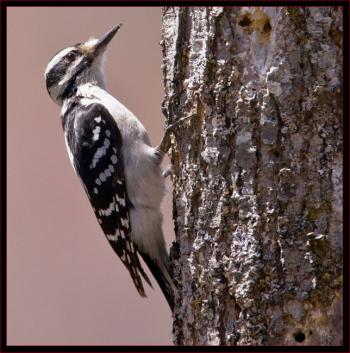The drumming of spring
If you haven’t heard it yet, chances are pretty good that you soon will. We’re talking about that rapid-fire rapping that arrives every spring. You may hear it from a tree or telephone pole; or, if the rapper is especially clever, you may hear it from a stop sign. Many a tired homeowner has even heard it from their own stove pipe or metal chimney.
We are, of course, talking about the drumming of woodpeckers. While other birds sing to establish their territories and attract a mate, it’s believed that woodpeckers drum for the same reason. Pounding on a loud, resonating surface will certainly do the trick of getting attention, as anyone who has heard them knows well.
To some, like us, the drumming of woodpeckers is a welcome sign of spring. To others, especially those who happen to have surfaces on their house that are perfectly suited to a drumming woodpecker’s purpose, the sounds can be a bit bothersome. Regardless of whether you enjoy the sound or wish it would just stop, like listening to a bird song, tuning into the drumming of a woodpecker yields clues to the species making the sound.
Some of the differences in drumming are not so subtle. The rap of a yellow-bellied sapsucker is especially distinctive, starting fast and ending slowly: raprapraprap, raprap, rap, rap. The northern flicker gives a fast, loud drumming that’s uneven and lasts about a second. The crow-sized pileated woodpecker, the largest of the woodpeckers found in the U.S. (since the apparent extinction of the ivory-billed) has a hollow-sounding rap that rolls through the air for several seconds. To us, it sounds like a jackhammer echoing in the distance.
Hairy and downy woodpeckers look similar in appearance, but just as there are differences in their plumage that make them distinctive, and so too are the characteristics of their drumming. Both have the classic rapid-fire rapping that’s familiar to most people, but that of the hairy is faster and has a somewhat buzzy quality (we liken it to the ringing of an “old fashioned” telephone). They tap an estimated 25 times per second and pause about 20 seconds between drums. The downy, on the other hand, taps about 15 times per second and typically pauses just a few seconds between drums.
With all that pounding and rattling, you may wonder, don’t they get some pretty bad headaches? The answer is no. One thing that prevents this is their thickened skulls. Another is their extremely strong neck muscles. Both of these distinctive features keep them from causing harm to their bodies. And while songbirds typically have three toes that face forward and one back, most woodpeckers have two forward-facing toes and two backward facing ones. This allows them to more easily climb and hang on to structures.
Including, quite possibly, your chimney.






























